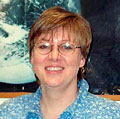 |
|
|
| Author |
Message |
Patty_Cie

Joined: 23 Mar 2004
Posts: 87

|
 Posted:
Mon Jun 07, 2004 7:30 am Posted:
Mon Jun 07, 2004 7:30 am |
  |
June 2, 2004 Wednesday
4:00 PM Alaska Time
Today on the back work deck I noticed Catherine Lalande preparing to set out her sediment traps. I went to investigate. First, with assistance from Coast Guard personnel and scientist, Pat Kelly, she laid out line on the deck so it would not become tangled when being deployed. Next, a lead weight was added to the line. The line was put overboard and lowered through the water column, stopping to add a ring of four collection tubes at five different depths: 30 m, 40 m, 50 m, 60 m, and 100 m. Then, Catherine added buoys to the line, both as a marker and to keep the traps at the correct depths. Finally, they tied off the trap to an ice floe using a large red buoy and some rope.
Ideally, the sediment traps stay submerged for 24 hours collecting particles as they drift down the water column. After the samples have been retrieved, Catherine filters the collected water and measures the amount of thorium-234 in the sediment. Using the same mathematical calculations as Pat Kelly and Kate Hagstrom (see May 31st journal entry), she determines the particulate organic carbon (POC) flux per day.
Catherine’s sampling technique has been used for many years, but is still considered experimental. Some scientists question whether the collected samples are really captured at the desired depths. She maintains they are and supports her assumptions with physics. First, water is denser than air. Second, the deeper the water, the more dense it becomes. As the empty tubes are submerged, the denser water flows into the trap. When the traps are retrieved, the samples stay in the tube because the water column they are moving through is less dense than the “at depth” collected water and sediment. Through data comparisons with other SBI projects, in particular Dr. Moran’s project, she hopes to further validate her data and resolve the controversy of her chosen sampling technique.

Catherine Lalande and MST2 Daniel Gaona are untangling line before the traps are deployed.

Catherine is posing with her sediment traps.

The buoys keep the sediments traps at the correct depth.
To see photographs taken by Steve Roberts of UCAR/JOSS, click here. |
|
|
    |
 |
|
|
|
View next topic
View previous topic
You cannot post new topics in this forum
You cannot reply to topics in this forum
You cannot edit your posts in this forum
You cannot delete your posts in this forum
You cannot vote in polls in this forum
You cannot attach files in this forum
You can download files in this forum
|
Powered by phpBB 2.0.11
© 2001, 2002 phpBB Group :: FI Theme ::
All times are GMT
| |
